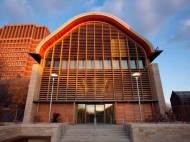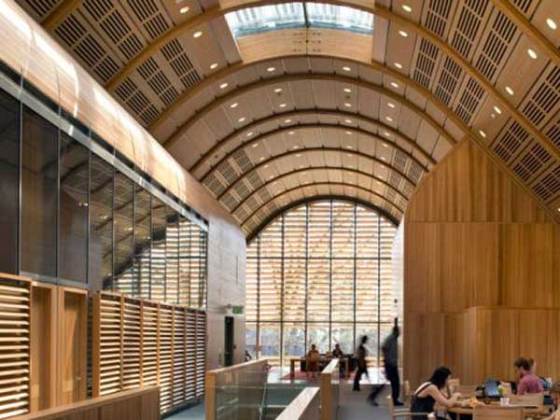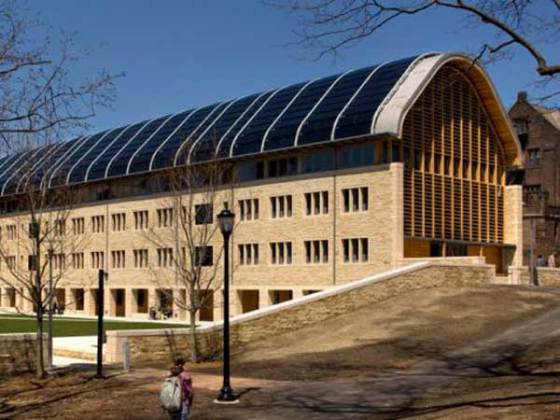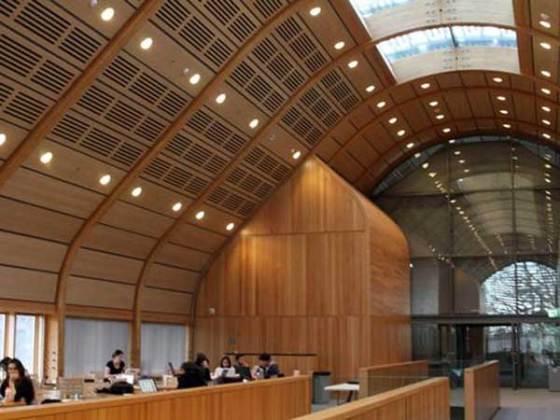Green architecture – Kroon Hall, Yale University
 The new home of the School of Forestry & Environmental Studies on Science Hill, Yale, was awarded with LEED Platinum certification. Designed by Hopkins Architects and Planners, in collaboration with Centerbrook Architects and Atelier Ten Environmental Designers, Kroon Hall incorporates a wide range of sustainable strategies and design features reflected in its maximum LEED rating.
The new home of the School of Forestry & Environmental Studies on Science Hill, Yale, was awarded with LEED Platinum certification. Designed by Hopkins Architects and Planners, in collaboration with Centerbrook Architects and Atelier Ten Environmental Designers, Kroon Hall incorporates a wide range of sustainable strategies and design features reflected in its maximum LEED rating.
Kroon Hall was built on a pre-developed site, following the campus masterplan to develop Yale’s Science Hill and the large open space surrounding the building. The site materials, such as light-colored concrete and the south courtyard’s green roof, were chosen to combat the urban heat island effect.
The building potable water usage is reduced to 81% below that of a comparable baseline building. Stormwater is collected from the roof and grounds and filtered through native aquatic plants. Wastewater collected from sinks and showers is added to the stormwater and used for all non-potable needs such as toilets and irrigation. Water demand is further reduced by the installation of low-flow plumbing and irrigation fixtures.
Kroon Hall uses 58% less energy than a comparable building of a similar size and program. The building earned 10 points for energy performance and 3 for on-site renewable energy. The rating was achieved through passive design, optimized lighting and incorporation of renewable energy sources on-site.
The east-west orientation of the building takes advantage of solar access and natural ventilation. The building is highly insulated and a green roof serves as a courtyard and covers a service lot and storage rooms below. Fresh air ventilation and free cooling cycles on air handling units reduce the need for air conditioning most of the year. Indicator lights alert occupants when conditions are suitable for opening windows. Concrete walls and exposed concrete ceilings retain heat in winter and help cool in the summer.
When air conditioning is necessary, displacement ventilation and indirect evaporative cooling condition the spaces using 75% less energy than a typical building. In winter, the heat recovery system warms the air using available energy from the occupants, lights, and appliances first, which is then supplemented by geothermal energy. High efficiency electric lighting and controls further reduce energy use and the cooling load. All appliances and equipment are Energy Star TM rated.
To offset some of the energy required by the extremely efficient Kroon Hall, solar energy is generated on the site. Solar hot water is used to heat at least 50% of potable water. The photovoltaic array on the roof, which was funded in part by the Connecticut Clean Energy Fund, provides approximately 25% of the building’s electricity. The all-electric building’s design protects the atmosphere by eliminating all on-site combustion. The ground source heat pumps serve as the building’s heating and cooling plant and utilize only HFC refrigerants.
Almost 80% of the timber purchased for the building is FSC Certified, and the building has 16% of the materials with recycled content and 34% from regional sources. One fourth of the awarded points were gained for Indoor Environmental Quality. Points are achieved for projects that maximize daylight and have views to the outdoors, use high-efficiency filtration for the ventilation air, give occupants control of their visual and thermal environment, and utilize finish products with low concentrations of volatile organic compounds.












Leave your response!